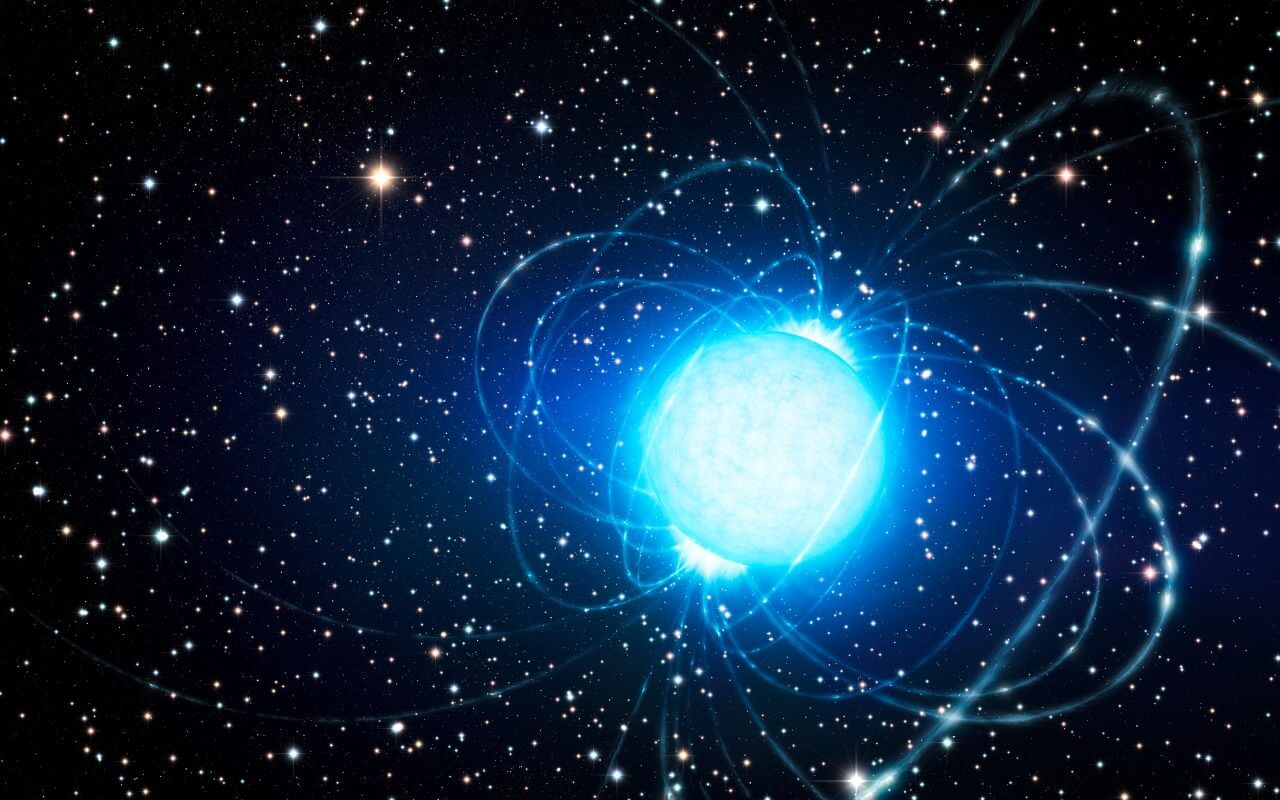[▲Figure: An imaginary illustration of a neutron star and the surrounding magnetic field of a type of neutron star called a magnetar that has a very strong magnetic field (Image credit: ESO/LCalçada)][▲الشكل:توضيحتخيليلنجمنيوترونيوالمجالالمغناطيسيالمحيطبهنوعمنالنجومالنيوترونيةيسمىنجممغناطيسيلهمجالمغناطيسيقويللغاية(رصيدالصورة:ESO/LCalçada)】
A star whose mass is more than 8 times the mass of the sun will explode in the form of a supernova at the end of its life, and the core will decompose and turn into a “star”.neutron star“, which is a compact, dense object with a diameter of more than 10 km. As the name suggests, neutron stars average (※ 1) , but the exact composition from the surface to the inside is thought to be different. especially,On the outside, there is an atmosphere made of ordinary atoms, leftover from when the star was a star.it is expected that
* 1 … A neutron is one of the particles that together with the proton form the atomic nucleus. A neutron star is, on average, an almost complete collection of high-density neutrons.
Assuming that the neutron star has an atmosphere, the X-rays emitted by the neutron star are affected by the atmosphere and become polarized. (※ 2) It has been theoretically proven to have an effect on X-rays, however, such polarization has not been observed before.
* 2 … When electromagnetic waves such as visible light and X-rays are viewed as “waves”, the fact that the waves’ vibrational directions align on a specific plane is called “polarized light”.
A research team, including Roberto Taverna from the University of Padua, said:magnetic“one of”4U0142+61He studied. Magnetars are a class of neutron stars with remarkably strong magnetic fields that are known to emit occasional bursts of energy. However, there are many points that are not clear about why magnetars have such strong magnetic fields and how they emit energy, And the search continues.4U 0142+61 has been a subject of long-term research because it is a relatively nearby magnetar, about 13,000 light-years from Earth.
Taverna et al. X-ray observing satelliteIXPEWe analyzed the observation data for 4U 0142+61 by `, and investigated the presence of polarization for each of the X-ray energy. As a result, we have succeeded for the first time in measuring the polarization of X-rays in neutron star radiation.
The degree of polarization of the observed X-rays varies with energy, for example, the values of linearly polarized light range from 2 to 8 keV. (※ 3) 13.5 ± 0.8% at 2 ~ 4 kV, 15.0 ± 1.0% at 5.5 ~ 8 kV, 35.2 ± 7.1% at 5.5 ~ 8 kV, and less than the detection sensitivity at 4 ~ 5 kV. On the other hand, the polarization angle was shown to change sharply to 90° between 4 and 5 keV.
* 3 … eV is a unit called “electron volt”. 1eV = 1.602 x 10^-19J, and is used as a unit of energy in the world of elementary particles such as x-rays = photons.
Based on these values, it is estimated that most of the X-rays emitted by 4U 0142+61 are emitted by solid surfaces near the equator, some of which are affected by the strength of the surrounding magnetic field.
Unexpectedly, from the X-ray emission data of 4U 0142+61 obtained this time,No visible presence in the atmosphere. This is an important point.
One possibility is that the atmosphere at the surface of the magnetar cannot maintain a gaseous state under the super-strong and intense magnetic field. This happens because (roughly) the properties of matter made up of ordinary atoms are determined by the state of the electrons on the outer surface of the atoms. Because electrons, which are electrically charged particles, interact with magnetic fields, there is a possibility that the electrons may undergo a change of state that causes the gas to solidify under the super-strong magnetic field of the magnetar.
Our observations are just one example, and we cannot settle the debate over whether magnetars and neutron stars have atmospheres. Magnetars, which have strong magnetic fields, and neutron stars, which are weaker than magnetars but have stronger magnetic fields than ordinary celestial bodies, may have different atmospheres. However, the current study was very successful in that it was possible to determine the presence or absence of a neutron star’s atmosphere from actual observational data. Since magnetars and other neutron stars have different magnetic field strengths, the presence of an atmosphere may depend on the strength of the magnetic field. Results of future research are expected.
Connection:NASA’s observing satellite captured X-ray images of the smallest ‘magnetar’ in observing history
source
Text: Rare Aya

“Travel maven. Beer expert. Subtly charming alcohol fan. Internet junkie. Avid bacon scholar.”







More Stories
Enjoy a hot cigarette while looking at whales and tropical fish under the sea ⁉︎ “Ploom Dive” is an amazing spatial video experience using Apple Vision Pro
Apple Watch now supports sleep apnea, watchOS 11 released – Impress Watch
ASCII.jp: New macOS Release! macOS Sequoia 15 Can Display Your iPhone Screen on Your Mac!